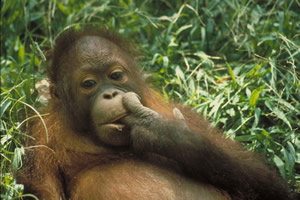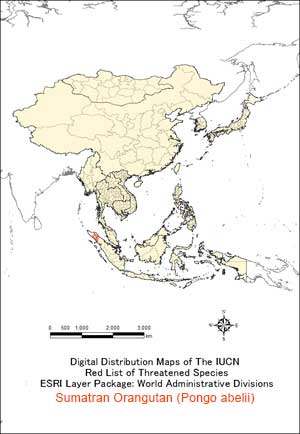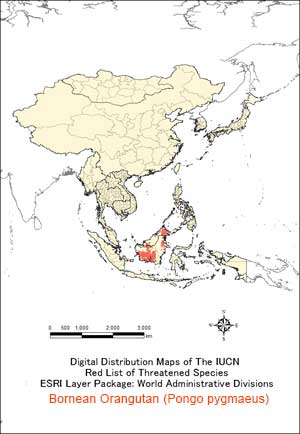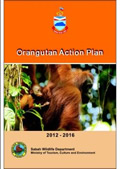
TOP > 生物多様性センターの国際協力 > ESABII > Database > Others > Orangutan

Orangutan

Orangutans are the most arboreal of the great apes, and one of the most intelligent primates along with chimpanzees and gorillas. They use a variety of sophisticated tools and construct elaborate sleeping nests each night from branches and foliage.? Orangutans have been known to the native people of Sumatra and Borneo for millennia.The name "orangutan" means "person of the forest".
TAXONOMY
- Bornean Orangutan: Pongo pygmaeus(Linnaeus, 1760),? EN in the IUCN Red List
- Sumatran Orangutan: Pongo abelii (Lesson, 1827),? CR in the IUCN Red List
HABITAT
The Sumatran Orangutan(Pongo abelii) is endemic to the island of Sumatra, Indonesia. It is generally restricted to the north of the island, north of the Batang Toru river on the west coast of North Sumatra province. The Bornean Orangutan (Pongo pygmaeus) is endemic to the island of Borneo where it is present in the two Malaysian states of Sabah and Sarawak as well as in three of the four Indonesian Provinces of Kalimantan. The species distribution is now highly patchy throughout the island of Borneo: it is apparently absent or uncommon in the southeast of the island as well as in the forests between the Rejang River in central Sarawak and the Padas River in western Sabah.


POPULATION
Sumatran Orangutan (Pongo abelii) : ca 7,300 (Singleton et al. 2004)
Bornean Orangutan (Pongo pygmaeus) : between 45,000 and 69,000
INTERNATIONAL CONSERVATION

The Bornean Orangutan is listed as EN in the IUCN Red List, and the Sumatran Orangutan is listed as CR in the IUCN Red List. Both are listed on Appendix I of CITES.
Since orangutans are symbol or flagship species for the conservation of wildlife, there are many international initiatives to protect orangutans and to conserve their habitat. Here we introduce some of these initiatives or projects.
Orangutan Foundation International
OFI is a nonprofit organization dedicated to the conservation of wild orangutans and their rainforest habitat. Founded by Dr. Birute Mary Galdikas and associates in 1986, OFI operates Camp Leakey, an orangutan research area within the Tanjung Puting National Park. OFI also runs the Orangutan Care Center and Quarantine (OCCQ) facility in the Dayak village of Pasir Panjang near Pangkalan Bun, which is home to 330 displaced orangutans, and helps manage the Lamandau Wildlife Reserve, where rehabilitated wild-born ex-captive orangutans are released into the wild. Through its field programs, OFI also provides employment at these facilities for over 200 local Indonesians.
For more Information Click HERE!
LOCAL CONSERVATION (National Action Plan)
INDONESIA:

In Indonesia, orangutans are strictly protected under domestic legislation UU No 5/1990, and Goverment Regulation no. 7 / 1999 (concerning the Preservation of Plants and Animals).
The Leuser Ecosystem conservation area of 2.6 million ha is supporting about 75% of the remaining Sumatran Orangutans. Within the Leuser Ecosystem is the designated 900,000 ha Gunung Leuser National Park, but this mountainous area supports only 25% of the orangutans. The Gunung Leuser National Park is also a Man and Biosphere reserve and part of the Tropical Rainforest Heritage of the Sumatra World Heritage Cluster Sites. Outside of the Leuser Ecosystem, there are no other notable large conservation areas harbouring this species.
In December 2007, President Susilo Bambang Yudhoyono launched Indonesia’s orangutan conservation strategy and action plan, which calls for all wild orangutan populations to be viable and stable by 2017. (Indonesian Orangutan Conservation Strategy and Action Plan 2007-2017)
Sumatran Orangutan Conservation Programme (SCOP)
The Sumatran Orangutan Conservation Programme is a unique collaborative programme of the PanEco Foundation, working with the Indonesian Government Forest Protection and Nature Conservation PHKA, Yayasan Ekosistem Lestrari YEL (Foundation for a Sustainable Ecosystem) and the Frankfurt Zoological Society. Their programme includes orangutan reintroduction, research, habitat protection and environmental education.
For more Information Click HERE!
Sumatran Orangutan Society
Sumatran Orangutan Society (SOS) is a non-profit organization that is dedicated to the protection of Sumatra's rainforests and champions the critically endangered Sumatran orangutan as an ambassador for the biodiversity of these fragile habitats.
For more Information Click HERE!
Orangutan Information Centre
The Orangutan Information Centre is a non-profit organization sponsored by the Sumatran Orangutan Society ,which is dedicated to the conservation of Sumatran orangutans and their habitat.
For more Information Click HERE!
MALAYSIA:

In Malaysia, orangutans are protected as a Totally Protected Species under the Law of Malaysia Act 76, Protection of Wild Life Act 1972 (Amend. 2006) . Totally protected species are those listed in Schedule 1 of the wildlife act.? No one may possess these species or any part or product from them without written authorisation from the Minister for Tourism Development, Environment, Science and Technology.
In Sabah, Under the Wildlife Conservation Enactment, 1997, there are provisions for the declaration of three types of protected areas. The first of these is Conservation Areas for the purpose of prompt and flexible protection of wildlife and habitats. Wildlife Sanctuaries is the strongest conservation category for fauna, flora, genetic resources and habitats. The third type is Wildlife Hunting Areas, intended for animal population management by regulated hunting. Some orangutan habitat is included in these protected area.
Although some major populations are found within the network of protected areas existing in Borneo, it is now well established that the vast majority of Bornean Orangutans live outside protected forests.
ORANGUTAN ACTION PLAN (The Sabah Wildlife Department)
In 2005, it was estimated that about 11,000 orangutans (95% Confidence Interval: 8,300-18,400) were distributed in fourteen major populations (i.e. populations with more than 25 individuals) in Sabah. In Sabah, the decline in orangutan distribution and abundance is directly attributed to recent and drastic habitat losses mainly due to the conversion of large expanses of orangutan habitat (lowland mixed dipterocarp forests) to oil palm plantations and other crops. Other immediate threats include habitat degradation due to unsustainable and/or illegal logging practices, various forms of encroachment on protected forests, forest fires and poaching/killing.
In the Sabah Action Plan, 14 high priority and The 5-year goals are identified to develop and implement strategies and actions that will address the threats to the species in all priority populations identified in the State by providing guidance to key players that will implement these strategies.
To see the Action Plan, Click HERE!
SWD:The Sabah Wildlife Department
As the main habitat of orangutans in Sabah, Mayasia, the Sabah Wildlife Department (SWD), under the Ministry for Tourism Development, Environment, Science and Technology is responsible for the implementation and administration of the Sabah Wildlife Conservation Enactment, 1997, including orangutan conservation. Under this Enactment the department conserves and regulates wildlife utilization in Sabah and it manages a number of protected areas. The department also implements the Convention on International Trade in Endangered Species of Wild Fauna and Flora (CITES) as well as contributing to the implementation of the international Convention on Biological Diversity and to a number of other international, regional and bilateral agreements.
SWD Established interagency collaboration and new approaches in monitoring and research on this species, and established the Kinabatangan Orang-utan Conservation Project together with HUTAN. SWD are also conducting natural rehabilitation and breeding programs, the translocation of doomed animals from areas where the loss of habitat and poaching are threatening their survival.? SWD and NGOs are working together in promoting public awareness for protection and conservation.
Sepilok Orang Utan Rehabilitation Centre
The Sepilok Orang Utan Rehabilitation Centre (SOURC), which is located at the entrance to Sepilok Forest Reserve in the Malaysian Sabah District of North Borneo, has been in existence since 1964 to rehabilitate orphan orangutans. Today around 60 to 80 orangutans are living free in the reserve. When Sabah became an independent state in Malaysia in 1963, a Game Branch was created in the Forest Department for the conservation of wild animals in the region. Consequently, 43 sq km of protected land at the edge of the Kabili Sepilok Forest Reserve was turned into a rehabilitation site for orangutans and a centre was built to care for the apes. Today around 25 young orphaned orangutans are housed in the nurseries, in addition to those free in the reserve.
The Centre offers a variety of nature experiences such as nature talks, wildlife photography exhibitions, live orang utan observation during feeding time in a semi-natural environment, filming, photography, etc.
For more Information Click HERE!
HUTAN-KOCP
HUTAN was first established as a French Non-Governmental Organization in 1996 by Dr. Isabelle Lackman, a primatologist, with Dr. Marc Ancrenaz, a wildlife veterinarian. In 1998, HUTAN, together with the Sabah Wildlife Department (SWD) established the Kinabatangan Orang-utan Conservation Project ? KOCP to carry out the aim of orangutan research and a conservation center was located in the village of Sukau in the heart of the Kinabatangan wetlands in eastern Sabah.
For more Information Click HERE!
BORNEO CONSERVATION TRUST
BORNEO CONSERVATION TRUST (BCT) is an NGO (non-governmental organisation) that was established in 2006. Its main aim is to deal with the pressing need to preserve the habitat and the migration routes of Borneo's most endangered wildlife including orangutans. The establishment of BCT was first mooted as an exciting and unprecedented concrete Malaysian-Japanese effort to 'buy back' alienated wetlands and riverine forests for restoration to their original state.
BCT aims to work in smart partnership with various stakeholders, including state government agencies and private landowners to manage, lease, or purchase lands within and in the vicinity of the proposed BCT Green Corridor area and ultimately to manage a sufficiently large green corridor.

